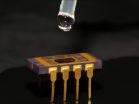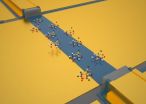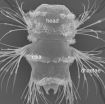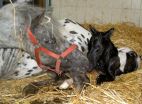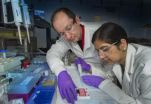(Press-News.org) This news release is available in German.
They are invisible, but perfectly suited for analysing liquids and gases; infrared laser beams are absorbed differently by different molecules. This effect can for instance be used to measure the oxygen concentration in blood. At the Vienna University of Technology, this technique has now been miniaturized and implemented in the prototype for a new kind of sensor.
Specially designed quantum cascade lasers and light detectors are created by the same production process. The gap between laser and detector is only 50 micrometres. It is bridged by a plasmonic waveguide made of gold and silicon nitride. This new approach allows for the simple and cheap production of tiny sensors for many different applications.
Laser and Detector
Simple solid-state lasers, such as the well-known red ruby laser, consist of only one material. Quantum cascade lasers, on the other hand, are made of a perfectly optimized layer system of different materials. That way, the properties such as the wavelength of the laser can be tuned. When a voltage is applied to the layer structure, the laser starts to emit light. But the structure can also work the other way around; when it is irradiated with light, an electric signal is created.
Now a method has been developed to create a laser and a detector at the same time, on one single chip, in such a way that the wavelength of the laser perfectly matches the wavelength to which the detector is sensitive. This bifunctional material was created atomic layer for atomic layer at the center for micro- and nanostructures at the Vienna University of Technology. "As both parts are created in one step, laser and detector do not have to be adjusted. They are already perfectly aligned", says Benedikt Schwarz.
Leading the Light to the Detector
In conventional systems, the laser light has to be transmitted to the detector using carefully placed lenses. Alternatively, optical fibres can be used, but they usually transport all the light inside, without letting it interact with the environment, and therefore they cannot be used as sensors.
In the new element created at the Vienna University of Technology, the optical connection between quantum cascade laser and detector works in a completely different way. It is a plasmonic waveguide, made of gold and silicon oxide. "The light interacts with the electrons in the metal in a very special way, so that the light is guided outside the gold surface", says Benedikt Schwarz. "That is why the light can be absorbed by the molecules on its way between laser and detector."
The sensor chip can be submerged in a liquid. By measuring the decrease of the detected light intensity due to the presence of light absorbing molecules, the composition of the liquid can be determined. The sensor was tested with a mixture of water and alcohol. The water concentration can be measured with an accuracy of 0.06%.
As the wavelength can be influenced by changing the design of the layered structure, this sensor concept can be applied to a wide variety of molecules such as carbohydrates or proteins, for many different applications in chemical, biological or medical analytics.
INFORMATION:
Published in Nature Communications.
Chemical sensor on a chip
Using miniaturized laser technology, a tiny sensor has been built at the Vienna University of Technology which can test the chemical composition of liquids
2014-06-11
ELSE PRESS RELEASES FROM THIS DATE:
Eye evolution: A snapshot in time
2014-06-11
This news release is available in German. Larvae of the marine bristle worm Platynereis dumerilii orient themselves using light. Early in their development, these larvae swim towards the light to use surface currents for their dispersal. Older larvae turn away from the light and swim to the sea floor where they develop into adult worms. Scientists of the Max Planck Institute for Developmental Biology in Tübingen have discovered that this change in the behavioural response to light is coupled to different neuronal systems underlying the eyes. The scientists have reconstructed ...
Foaling mares are totally relaxed -- no stress
2014-06-11
Foaling in horses is extremely fast. Labour and the active part of foaling, resulting in delivery of the foal, take 10 to 20 minutes and are considerably shorter than giving birth in humans or in cows. Is this brief period stressful for the animals or are horses more relaxed than humans when giving birth? This issue has been addressed by Christina Nagel and colleagues, who closely observed 17 foalings at the Brandenburg State Stud in Neustadt (Dosse), Germany, as well as recording electrocardiograms before, during and after foaling. The researchers also took samples of ...
Making new species without sex
2014-06-11
This news release is available in German. Occasionally, two different plant species interbreed with each other in nature. This usually causes problems since the genetic information of both parents does not match. But sometimes nature uses a trick. Instead of passing on only half of each parent's genetic material, both plants transmit the complete information to the next generation. This means that the chromosome sets are totted up. The chromosomes are then able to find their suitable partner during meiosis, a type of cell division that produces an organism's reproductive ...
Having authoritarian parents increases the risk of drug use in adolescents
2014-06-11
Alcohol, tobacco and cannabis use is very widespread among youths in Spain compared to the majority of European countries, according to the latest data from the European Monitoring Centre for Drugs and Drug Addiction.
An international team, led by the European Institute of Studies on Prevention (IREFREA) with headquarters in Mallorca, together with other European and Spanish universities (Oviedo, Santiago de Compostela and Valencia), has analysed the role that parents play at the time of determining the risk of their children using alcohol, tobacco and cannabis in six ...
Herpes infected humans before they were human
2014-06-11
Researchers at the University of California, San Diego School of Medicine have identified the evolutionary origins of human herpes simplex virus (HSV) -1 and -2, reporting that the former infected hominids before their evolutionary split from chimpanzees 6 million years ago while the latter jumped from ancient chimpanzees to ancestors of modern humans – Homo erectus – approximately 1.6 million years ago.
The findings are published in the June 10 online issue of Molecular Biology and Evolution.
"The results help us to better understand how these viruses evolved and found ...
Canadian physicians lack knowledge and confidence about breastfeeding
2014-06-11
OTTAWA, Ontario – June 11, 2014 –The results of a national research project to assess breastfeeding knowledge, confidence, beliefs, and attitudes of Canadian physicians are available today in the Journal of Human Lactation.
"Physicians' attitudes and recommendations are known to directly impact the duration that a mom breastfeeds," said Dr. Catherine Pound, pediatrician and lead author of the study at the Children's Hospital of Eastern Ontario (CHEO). "Worldwide healthcare organizations readily promote the benefits of breastfeeding, and yet now we find a gap exists where ...
Researchers identify regulation process of protein linked to bipolar disorder
2014-06-11
BOSTON (June 11, 2014) — Researchers from Tufts have gained new insight into a protein associated with bipolar disorder. The study, published in the June 3 issue of Science Signaling, reveals that calcium channels in resting neurons activate the breakdown of Sp4, which belongs to a class of proteins called transcription factors that regulate gene expression.
This study, led by Grace Gill, identifies a molecular mechanism regulating Sp4 activity. Her previous research had determined that reduced levels of Sp4 in the brain are associated with bipolar disorder. Her work ...
DNA-linked nanoparticles form switchable 'thin films' on a liquid surface
2014-06-11
UPTON, NY—Scientists seeking ways to engineer the assembly of tiny particles measuring just billionths of a meter have achieved a new first—the formation of a single layer of nanoparticles on a liquid surface where the properties of the layer can be easily switched. Understanding the assembly of such nanostructured thin films could lead to the design of new kinds of filters or membranes with a variable mechanical response for a wide range of applications. In addition, because the scientists used tiny synthetic strands of DNA to hold the nanoparticles together, the study ...
Scientists unravel the genetic secrets of nature's master of mimicry
2014-06-11
Scientists investigating how one of the greatest shape shifters in the natural world is able to trick predators to avoid being eaten have identified the gene behind the fascinating feat.
The African Swallowtail butterfly, also known as the 'Mocker Swallowtail' or the 'Flying Handkerchief,' can appear to change both colour and shape.
Males of the species fly boldly around the tree tops, their rapid flight making them look like shaking handkerchiefs, however females lurk in the bushes and pretend to be examples of Monarch butterflies that are nasty to eat.
The females ...
Infant nutrition and development of type 1 diabetes
2014-06-11
Previous studies have indicated that early exposure to complex foreign proteins, such as cow's milk proteins, increases the risk of type 1 diabetes in predisposed individuals.
"Therefore, In 2002, we embarked on a large-scale study on more than 2100 infants with a family member affected by type 1 diabetes and with genetic disease susceptibility to find an answer to the question whether delaying the exposure to complex foreign proteins will decrease the risk of diabetes", tells Professor Mikael Knip from the University of Helsinki, the leader of the TRIGR Study.
After ...
LAST 30 PRESS RELEASES:
What causes some people’s gut microbes to produce high alcohol levels?
Global study reveals widespread burning of plastic for heating and cooking
MIT study shows pills that communicate from the stomach could improve medication adherence
Searching for the centromere: diversity in pathways key for cell division
Behind nature’s blueprints
Researchers search for why some people’s gut microbes produce high alcohol levels
Researchers find promising new way to boost the immune response to cancer
Coffee as a staining agent substitute in electron microscopy
Revealing the diversity of olfactory receptors in hagfish and its implications for early vertebrate evolution
Development of an ultrasonic sensor capable of cuffless, non-invasive blood pressure measurement
Longer treatment with medications for opioid use disorder is associated with greater probability of survival
Strategy over morality can help conservation campaigns reduce ivory demand, research shows
Rising temperatures reshape microbial carbon cycling during animal carcass decomposition in water
Achieving ultra-low-power explosive jumps via locust bio-hybrid muscle actuators
Plant-derived phenolic acids revive the power of tetracycline against drug-resistant bacteria
Cooperation: A costly affair in bacterial social behaviour?
Viruses in wastewater: Silent drivers of pollution removal and antibiotic resistance
Sub-iethal water disinfection may accelerate the spread of antibiotic resistance
Three in four new Australian moms struggle with body image
Post-stroke injection protects the brain in preclinical study
Cardiovascular risk score predicts multiple eye diseases
Health: estimated one in ten British adults used or interested in GLP-1 medications for weight loss
Exercise to treat depression yields similar results to therapy
Whooping cough vaccination for pregnant women strengthens babies’ immune system
Dramatic decline in new cases of orphanhood in Uganda driven by HIV treatment and prevention programs
Stopping weight loss drugs linked to weight regain and reversal of heart health markers
Higher intake of food preservatives linked to increased cancer risk
Mass General Brigham–developed cholera vaccine completes phase 1 trial
First experimental validation of a “150-year-old chemical common sense” direct visualization of the molecular structural changes in the ultrafast anthracene [4+4] photocycloaddition reaction
Lack of support for people on weight loss drugs leaves them vulnerable to nutritional deficiencies, say experts
[Press-News.org] Chemical sensor on a chipUsing miniaturized laser technology, a tiny sensor has been built at the Vienna University of Technology which can test the chemical composition of liquids
